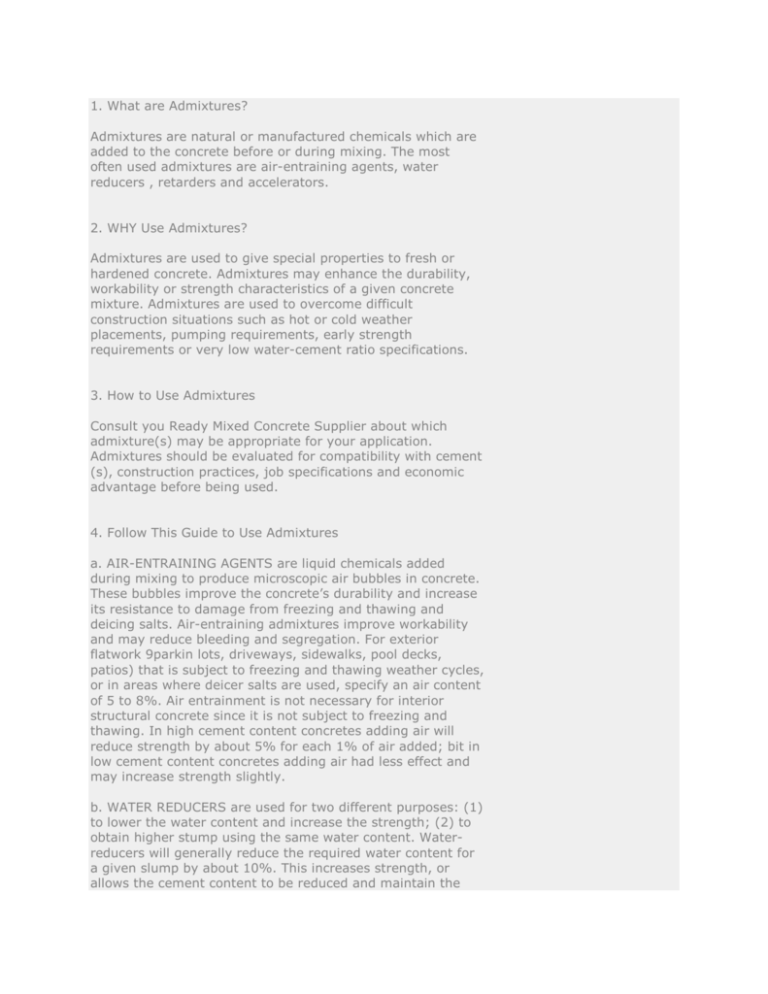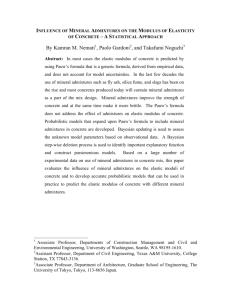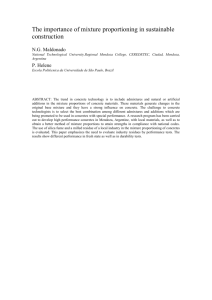1. What are Admixtures? Admixtures are natural or manufactured
advertisement

1. What are Admixtures? Admixtures are natural or manufactured chemicals which are added to the concrete before or during mixing. The most often used admixtures are air-entraining agents, water reducers , retarders and accelerators. 2. WHY Use Admixtures? Admixtures are used to give special properties to fresh or hardened concrete. Admixtures may enhance the durability, workability or strength characteristics of a given concrete mixture. Admixtures are used to overcome difficult construction situations such as hot or cold weather placements, pumping requirements, early strength requirements or very low water-cement ratio specifications. 3. How to Use Admixtures Consult you Ready Mixed Concrete Supplier about which admixture(s) may be appropriate for your application. Admixtures should be evaluated for compatibility with cement (s), construction practices, job specifications and economic advantage before being used. 4. Follow This Guide to Use Admixtures a. AIR-ENTRAINING AGENTS are liquid chemicals added during mixing to produce microscopic air bubbles in concrete. These bubbles improve the concrete’s durability and increase its resistance to damage from freezing and thawing and deicing salts. Air-entraining admixtures improve workability and may reduce bleeding and segregation. For exterior flatwork 9parkin lots, driveways, sidewalks, pool decks, patios) that is subject to freezing and thawing weather cycles, or in areas where deicer salts are used, specify an air content of 5 to 8%. Air entrainment is not necessary for interior structural concrete since it is not subject to freezing and thawing. In high cement content concretes adding air will reduce strength by about 5% for each 1% of air added; bit in low cement content concretes adding air had less effect and may increase strength slightly. b. WATER REDUCERS are used for two different purposes: (1) to lower the water content and increase the strength; (2) to obtain higher stump using the same water content. Waterreducers will generally reduce the required water content for a given slump by about 10%. This increases strength, or allows the cement content to be reduced and maintain the same water-cement ratio. Water reducers are used to increase slump for pumping concrete and are used in hot weather to offset the increased water demand. Water reducers may aggravate slump loss problems. Water reducers tend to retard concrete and sometimes have accelerators blended in to offset the retardation. Water reducers are Type A Chemical Admixtures in ASTM C 494. c. RETARDERS are chemicals which delay the initial set of concrete by hour or more. Retarders are often used in hot weather to counter the rapid setting caused by high temperatures. For large jobs, or in hot weather, specify concrete with a retarder to allow more time for placing and finishing. Most retarders also act as water reducers. Retarders are covered by ASTM C 494 Types B and D. d. ACCELERATORS reduce the initial set time of concrete. Liquid accelerators are added to the concrete at the plant. Accelerators are recommended in cold weather to get high early strength. Accelerators do not act as an antifreeze; rather, they speed up the strength gain and make the concrete stronger to resist damage from freezing. Accelerators are sometimes used to allow finishing operations to begin early. Calcium chloride is the most commonly used accelerator although non chloride (non-corrosive) accelerators are available. Calcium chloride is specified at not more than 2% by the weight of the cement. Pre-stressed concrete and concrete with embedded aluminum or galvanized metal should not contain any calcium chloride because of the potential for corrosion. Accelerators are covered by ASTM C 494 Types C and E. e. HIGH RANGE WATER REDUCERS (HRWR) are a special class of water reducers. Often call superplasticizers, HRWRs reduce the water content of a given concrete from 12 to 25%, which increases strength. HRWRs can greatly increase the slump to produce “flowing” concrete. For example, adding a normal dosage of HRWR to a concrete with a normal dosage of HRWR to a concrete with a slump of 75-100mm will produce a concrete with a slump of about 200mm. Within 30 to 60 minutes the concrete will return to its original slump. HRWRs are covered by ASTM Specification C 494. Types F and G, and C 1017 Types 1 and 2. × close close







